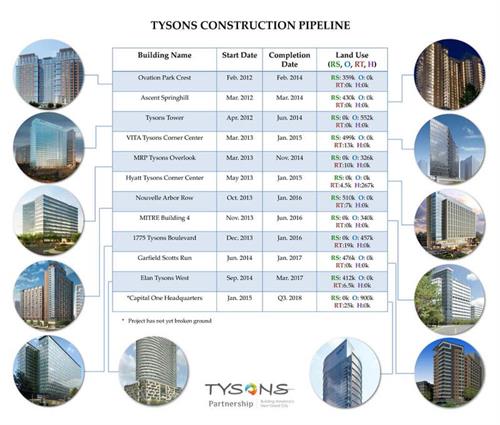The transformation currently underway in Northern Virginia’s Tysons development leaves no room for small dreams.
Fortunately, there are plenty of big dreamers implementing their plans to remake the area formerly called Tysons Corner. Its promoters like to call the once automobile-dependent suburban commuter retail and office complex “the next Great American City,” with the updated moniker, “Tysons.”
Amazingly the two commercial centers emerging in Northern Virginia -- Tysons and its western neighbor Reston -- didn’t even exist 50 years ago, except in the imaginations of a handful of developers and urban planners.
As 2015 rolls around, Tysons is on its way to achieving its new status. Since 2010, Fairfax County has approved more than 27 million square feet of new development, about half of which is residential, according to Michael Caplin, CEO of Tysons Partnership. The organization was created by the Fairfax County Board of Supervisors to bring businesses and homeowners together with county planners to work out their goals and tactics for redevelopment.
Transportation is the key to Tysons redevelopment. The convergence of the Capital Beltway (I-495), Leesburg Pike (Route 7) and Dolly Madison Highway (Route 123) gave birth in 1965 to Tysons Corner as a drivable suburban destination. Last summer’s addition of Metro’s Silver Line fed by new Connector buses, goes beyond just moving people, to creating the new urban center’s economic development. During its first week of operation last summer the Silver Line added more than 6,000 riders per day at the five new Metro stations, many of them coming to Tysons, not just from Tysons into downtown DC.

Staying focused on what he calls “the common good,” Caplin pointed out that many of the participants in the Partnership are natural competitors, but in order to improve the quality of life in the area “we all need to succeed.”
As an example of how the area is beginning to change its character into more of an urban center, Caplin pointed to the new Tysons “Plaza.” Surrounded by new high-rise buildings, the Plaza has taken on the role of a town square with concerts, festivals, an ice skating rink, and for the holidays an enormous Christmas tree. Tysons is attracting visitors from throughout the metropolitan area, many of them coming and going on the Silver Line. Soon a Hyatt Regency Hotel and an additional residential tower will join the new buildings circling the Plaza, which already includes the Intelsat headquarters building that opened its doors last fall.
“Reston showed that people respond to this kind of development,” Caplin acknowledged. “It will come to Tysons in fits and starts, but it will get here.
“To have so much open space is really unusual in urban development, and you can do stunning original projects with our location,” Caplin predicted. “The success of the early projects is so dynamic that it will drive the next phase, and residential will continue to be added at a rapid pace.”
“This area will continue to be in a constant state of flux for the next 30 years.”
Indeed, in November Fairfax County approved Dittmar Company’s redevelopment of the 5.37 acre Westpark Plaza from its current aging hotel and expansive open asphalt covered parking area into a planned construction of three new towers, centered around a two-acre park sitting atop a five-story underground parking garage for more than 2,200 cars. Two of the towers will be more than 30 stories high, providing 600 and 700 new residential units each. The third tower will be a new high rise hotel, with up to 250 rooms. A Metro stop is conveniently located near its front doors opening on Leesburg Pike.
Construction is also soon to begin on the new 995,000 square foot Capital One headquarters tower. At 470 feet high, it will be the tallest building in the region. Prior to starting construction, Capital One provided $75,000 in landscaping to beautify Dolly Madison Highway as it passes through Tysons and the McLean Metro stop, near the Capital One location.
Clark Tyler, head of the nearby Hallcrest Homeowners Association in McLean, has been an active member of the Partnership since its inception.
“The Partnership has done a wonderful job keeping everyone on the same page and including the needs of existing homeowners in the area with projects like landscaping, noise barriers and constructing sidewalks to improve pedestrian access from McLean to Tysons,” Tyler said.
“This area will continue to be in a constant state of flux for the next 30 years,” Caplin predicted, “as each new development launches a project, they will need to build the infrastructure as it comes.”
As the area continues to redevelop and new buildings come on line, Commercial Realtors® will be busy providing tenants for the growing mix of office and retail properties. A bigger challenge may be finding creative ways to fill and reuse existing commercial space left behind by tenants upgrading to the new locations.
Frank Dillow was the 2014 chair of NVAR's Realtor® Commercial Council and is a vice president in Long & Foster's Commercial Division. He can be reached at francis.dillow@longandfoster.com.